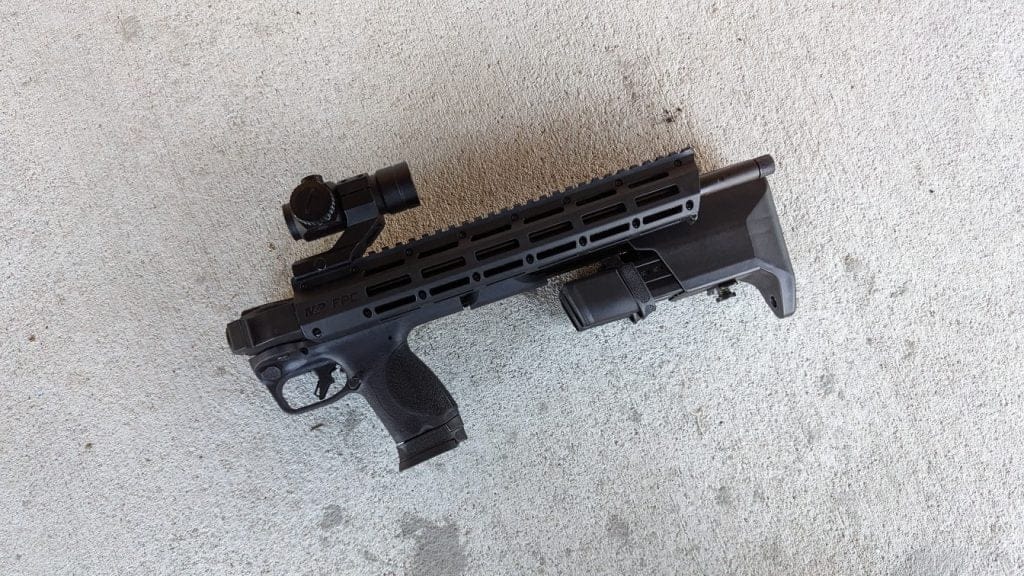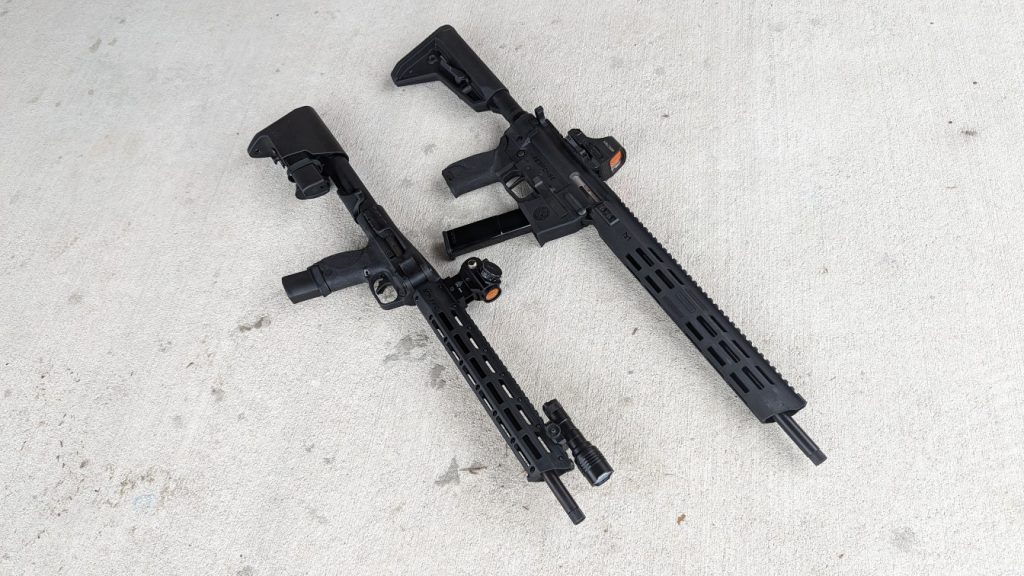Smith & Wesson established its reputation as a revolver company and is one of the few major American revolver companies still in the market. With that said, they produce a wide variety of firearms. This includes modern polymer frame automatics, AR-15s, a shotgun, and PCCs. In fact, for S&W, 2023 was the year for pistol-caliber carbines. Smith & Wesson came out of nowhere and released two within just a few months of each other. The S&W Response and the S&W FPC are fascinating, exciting pistol-caliber carbines.
They have much in common but are also quite different in their design. One feature they have in common is that they utilize the S&W M&P series magazines, specifically the 9mm version. This gives M&P shooters two options to use their handgun mags in their rifles. If you can purchase one magazine with multiple guns, it makes your purchase go a little further.
While they might share magazines, the big reason why I’m comparing the two today is that they are both S&W PCCs released this year. With two releases, it’s easy to look at both and wonder which one you should choose. But without further ado, let’s compare and contrast the two.
Smith & Wesson PCCs: The Big Difference
Let’s get the big folding elephant in the room out of the way. The guns are very similar when you break them down, but there is one huge difference we need to address. FPC stands for folding pistol carbine. The FPC folds in half, and the Response does not. This creates a pretty big difference that needs to be addressed.

Being able to fold in half makes the firearm very compact and easy to store. You can stash it with ease in the very nice carry bag. It fits easily in a trunk or toolbox. Is folding better? Maybe, but it depends on your needs. However, a folding design has some inherent compromises in the ergonomics and layout department. With that in mind, let’s dig into the Response and the FPC and break them down into several different categories to see which gun does what better.
Weight and Size
When we get into the world of pistol-caliber carbines, I believe weight and size become even more important than for other categories of firearms. If I’m using a rifle to fire a pistol caliber, then I want the platform to be light and handy. That’s one of the benefits of using a pistol-caliber carbine compared to a more proper rifle. Unfortunately, something called the NFA exists that restricts the length of rifle barrels to 16 inches without a tax stamp.

Both guns have 16-inch barrels. The Smith & Wesson FPC uses a magazine in the pistol grip-like design pioneered by the Uzi, which creates a shorter overall platform at 30.3 inches. The Response is an AR-type rifle and is a hair over 35 inches with the stock fully extended. The FPC’s ability to fold allows the gun to collapse to 16.3 inches overall.
The FPC is also a good bit lighter, at five pounds and one ounce, compared to the Response, which weighs 6.2 pounds overall. Both weapons are fairly small and compact, but the FPC wins if you want the lightest, smallest gun.
Calibers and Magazines
As mentioned before, these PCCs are both ready to function with the S&W M&P pistol magazines and are also 9mm carbines. The FPC comes with two 23-round magazines and one 17-round magazine, while the Response comes with two 23-round M&P magazines. One extra magazine does give the FPC a slight advantage.

An advantage that the FPC immediately loses to the Response is the latter’s modular magwell design. The Response has a removable magwell and comes with a Glock magwell that just slips in with ease. Swapping the magazine wells around is very simple and requires an Allen key.
Currently, only the S&W and Glock options exist, but other mag wells are possible. How about Sig Sauer or CZ options? Heck, it might be possible to introduce a Colt SMG-type magwell or even something nuttier like the CZ Scorpion. It isn’t impossible for S&W to release a different upper and maybe a different buffer to make caliber conversions possible. But as it stands now, the Smith & Wesson Response and FPC are coming from the factory chambered in 9mm Luger.
Accuracy
I equipped both guns with red dots and shot at 25 yards offhand. I shot three groups with each gun, and honestly, there isn’t much of a difference in terms of accuracy. Both guns will produce tight groups, with each round nearly touching at this range.

Even back to 50 yards on steel, I didn’t notice much of an accuracy difference. The only real advantage was that if you wanted to, you could mount a magnified optic to the Response. This would make accurate shooting a little bit easier at various ranges.
The guns both offer good supportive stocks and reliable triggers. The triggers are different. With the Response, we get your standard AR-type trigger. It’s light, sweet, and predictable. On the flip side, the FPC has a seemingly identical trigger to the S&W M&P pistol series. It has the trigger dingus, a light pull, and a good chunky reset.
Handling and Recoil
Both guns use a pretty standard bare-bones straight blowback system. The straight blowback design can be rough with other guns, but It’s surprisingly nice on the FPC and Response. The Response seems to have lighter recoil and muzzle rise, which is likely related to the layout and AR-like design. In running Bill Drills, I could always finish a little quicker with the Response over the FPC. However, the FPC always finished well within the six seconds allotted.
Ergonomics
Ergonomically, the guns are vastly different. This is where the folding nature of the FPC has its biggest downside. The M&P 2.0 series heavily influences the FPC in terms of controls and layout. This includes the magazine release that doesn’t directly translate to the rifle well. Namely, the button feels tough to reach when there is a stock in your shoulder. If you reload it more like a handgun, it works. The slide release is also super small and useless for reloads.

The FPC’s layout generally makes it a little awkward. It’s made compromises to be a folding carbine, and it shows. The Response gets all the benefits of the AR. This includes excellent safety, a charging handle, a bolt release, and a collapsing stock.
In reload drills, the Response is about 1.25 seconds faster on average. This cuts your reload time significantly and makes it quicker to get back on target and keep conducting business.
The FPC’s stock is very supportive and nice, and it has the ability to stash two magazines. Theoretically, with three 23-round magazines, you could have 69 rounds on the gun. Nice. The Response comes with an excellent Magpul MOE SL stock, which is to die for in terms of comfort and support.

Both guns use the M&P-style grip design and come with interchangeable backstraps that make it easy to tailor the gun to your hand size.
Price
The Smith & Wesson Response has an MSRP of $799, and the FPC has an MSRP of $659. That’s a big price difference. We should also keep in mind a few different factors. The FPC is cheaper and also comes with a really nice bag for carrying the gun. The FPC also comes with three magazines instead of two. The Response does come with two mag wells, so right off the bat, you can swap to Glock mags if you so choose.
Which is better?
One isn’t better than the other. Both are lightweight, easy to shoot, fun, accurate, and reliable guns. Both are still just PCCs. While one isn’t better than the other overall, they are distinct enough to be better at different things. If I wanted a low-profile, easily transportable rifle, then the FPC wins. If I wanted something for the PCC competition, then the Response wins.

For home defense, it’s a toss-up. However, I’d likely go with the shorter, lighter FPC inside the home. That’s just me. Overall, S&W has two winners, with great features and design. The real winner is determined by your overall purpose rather than a single trait or feature.

